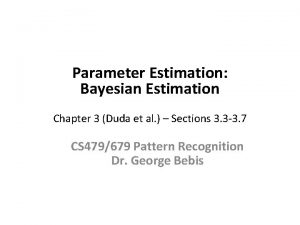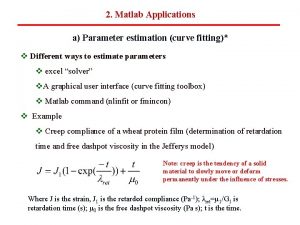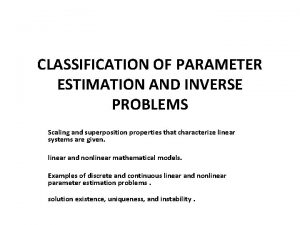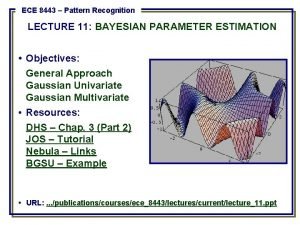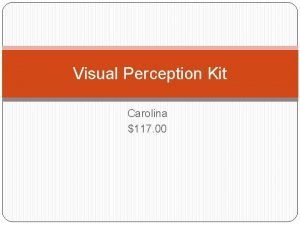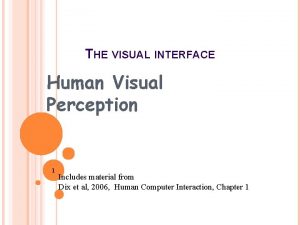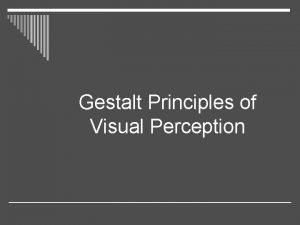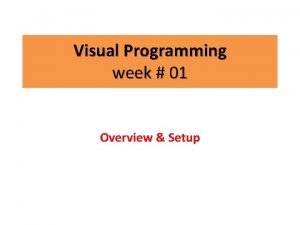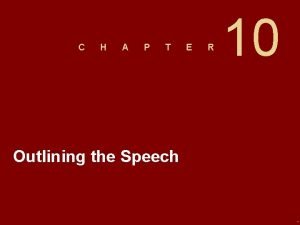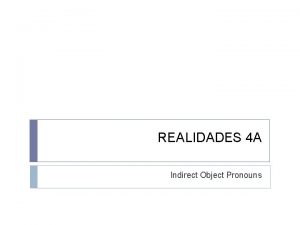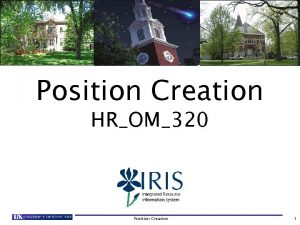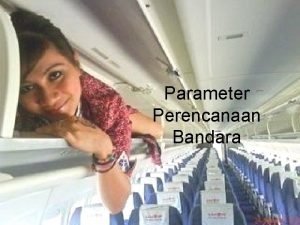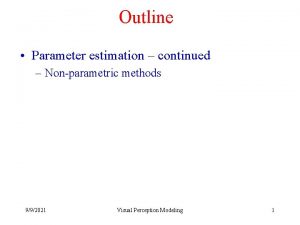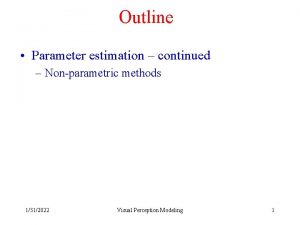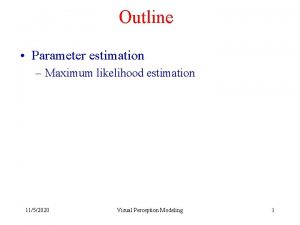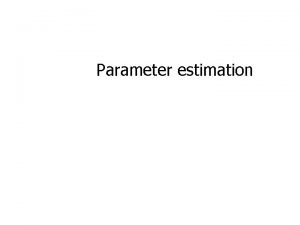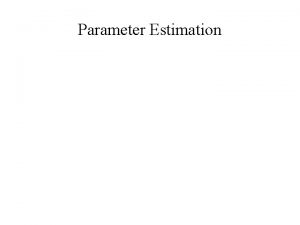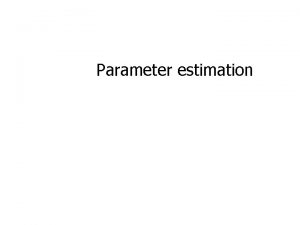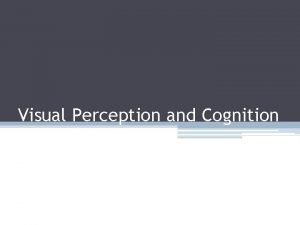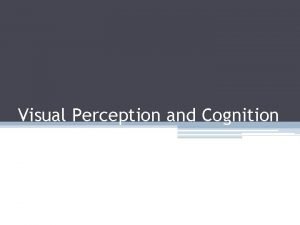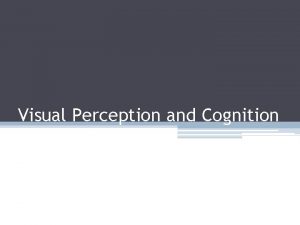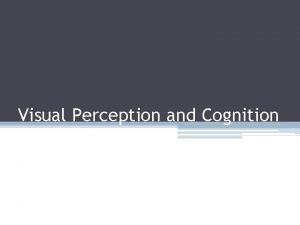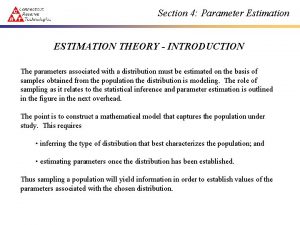Outline Classification continued Parameter estimation 1232020 Visual Perception



















- Slides: 19

Outline • Classification – continued • Parameter estimation 12/3/2020 Visual Perception Modeling 1

Assumptions • Suppose that there are c categories – { 1, 2, . . . , c} • The prior probability and class conditional density are known • There a possible actions – { 1, 2, . . . , a} • Loss function ( i | j} describe the loss incurred for taking action i when the state of nature is j 12/3/2020 Visual Perception Modeling 2

Loss Function • The expected loss function given a particular observation x • The overall risk 12/3/2020 Visual Perception Modeling 3

Bayes Decision Rule • To minimize the overall risk, compute the conditional risk and select the action for which the conditional risk is minimum – The resulting minimum overall risk is called the Bayes risk, which is the best performance 12/3/2020 Visual Perception Modeling 4

Minimum-Error-Rate Classification • Zero-one loss • For minimum error rate, – Decide 1 if P( 1 | x) > P( 2 | x) – This is the Bayes decision rule 12/3/2020 Visual Perception Modeling 5

Discriminant Functions • The classifier is said to assign a feature vector x to class i if – gi(x) > gj(x) for all j i – This can be viewed as a network – If f(. ) is a monotonically increasing function, f(g(x)) and g(x) as discriminant function will give the same classification result 12/3/2020 Visual Perception Modeling 6

Decision Regions • The effect of decision rule is to divide the feature space into c decision regions – R 1, R 2, . . , Rc – The regions are separated by decision boundaries 12/3/2020 Visual Perception Modeling 7

Normal Density • Gaussian density – Properties • • 12/3/2020 Mean Variance Entropy Central limit theorem Visual Perception Modeling 8

Discriminant Functions for Normal Density • Minimum error rate classification for normal density 12/3/2020 Visual Perception Modeling 9

Normal Density – Cont. • Case I: – i = 2 I – Linear discriminant function – Minimum distance classifier as a special case • Template matching 12/3/2020 Visual Perception Modeling 10

Normal Density – Cont. • Case II – i = – Mahalanobis distance – The resulting discriminant function is also linear 12/3/2020 Visual Perception Modeling 11

Normal Density – Cont. • Case III – i arbitrary – Hyper-quadric 12/3/2020 Visual Perception Modeling 12

Bayes Decision Theory – Discrete Features • In this case, a feature can only take one of the m discrete values v 1, . . . , vm • To minimize the overall risk, select the action that minimizes 12/3/2020 Visual Perception Modeling 13

Parameter Estimation • We could design an optimal classifier if we knew the prior probabilities and the classconditional densities – Unfortunately, in pattern recognition applications we rarely have this kind of complete knowledge about the probabilistic structure of the problem • Training data – Some vague, general knowledge about the problem – A number of design samples 12/3/2020 Visual Perception Modeling 14

Parameter Estimation – cont. • Two approaches – Parameter estimation • Estimate the parameters of the unknown probabilities and probability densities – Non-parametric procedures • Multi-layer perceptrons and in general neural networks • Fisher linear discriminant function 12/3/2020 Visual Perception Modeling 15

Parameter Estimation – cont. • Parameter estimation – Maximum-likelihood approach • Parameters as quantities whose values are fixed but unknown • The best estimate of their value is the one that maximizes the probability of obtaining the samples – Bayesian learning • Parameters are random variables with known prior distribution • Observations convert the prior into posteriori 12/3/2020 Visual Perception Modeling 16

Maximum-Likelihood Estimation • The general principle – Log-likelihood • Gaussian cases – Unknown and 12/3/2020 Visual Perception Modeling 17

Bayesian Estimation • Class-conditional densities • Parameter Distribution • Gaussian case – Univariate case – Multivariate case 12/3/2020 Visual Perception Modeling 18

Bayesian Estimation – cont. • General theory 12/3/2020 Visual Perception Modeling 19
 Head halter traction definition
Head halter traction definition Bayesian parameter estimation in pattern recognition
Bayesian parameter estimation in pattern recognition Parameter estimation in matlab
Parameter estimation in matlab Parameter estimation and inverse problems
Parameter estimation and inverse problems Bayesian parameter estimation in pattern recognition
Bayesian parameter estimation in pattern recognition Gestalt figure ground tessellation
Gestalt figure ground tessellation Carolina visual perception kit
Carolina visual perception kit Perception
Perception Visual
Visual Quotation sandwich
Quotation sandwich Ai2.appinventor.mit.edu emulator
Ai2.appinventor.mit.edu emulator The visual framework of a preparation outline
The visual framework of a preparation outline What is visual comunication
What is visual comunication The visual framework of a preparation outline
The visual framework of a preparation outline Jelaskan definisi pemrograman visual
Jelaskan definisi pemrograman visual Romeo and juliet act 2 script
Romeo and juliet act 2 script Romeo and juliet act 4 scene 2 questions
Romeo and juliet act 4 scene 2 questions Indirect object pronouns (p 199 continued) answers
Indirect object pronouns (p 199 continued) answers Continued abbreviation
Continued abbreviation Signal words example
Signal words example

